A/R Reports section.
To view Invoice information, select the "Invoice Information" option. The following screen will appear:
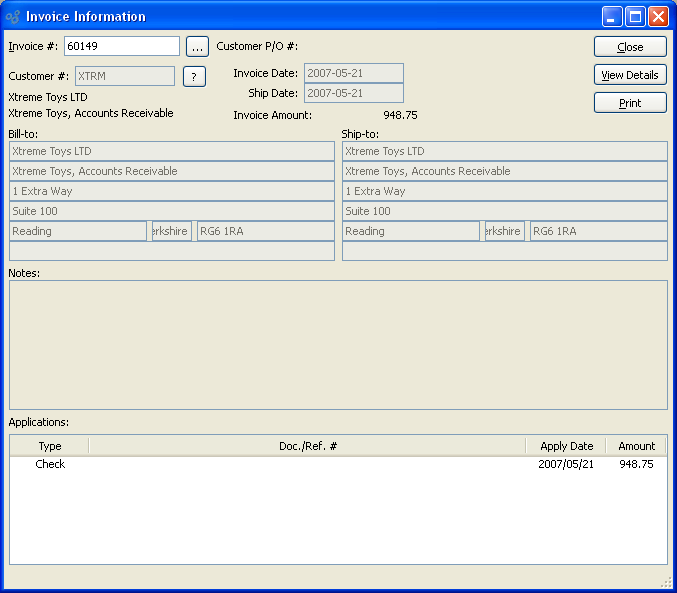
When displaying Invoice information, you are presented with the following options:
- Invoice #
Enter the Invoice Number of the Invoice whose information you want to display.
- Customer #
Displays the Customer Number of the Customer associated with the specified Invoice. The Customer name and billing address will also display.
- Customer P/O #
Displays related Customer Purchase Order Number, if any.
- Invoice Date
Displays the date the Invoice was created.
- Ship Date
Displays the date the Invoice Items were shipped.
- Invoice Amount
Displays the amount due on the Invoice.
- Bill-To
Displays the Customer's Bill-To Address.
- Ship-To
Displays the Ship-To Address used for the specified Invoice.
- Notes
Displays any Notes associated with the Invoice.
- Applications
Display lists associated applications.
To the far right of the screen, the following buttons are available:
- CLOSE
Closes the screen, returning you to the application desktop.
- VIEW DETAILS
Select to view the original Invoice.
Runs the report associated with this screen.
To view A/R open items, select the "Open Items" option. The following screen will appear:
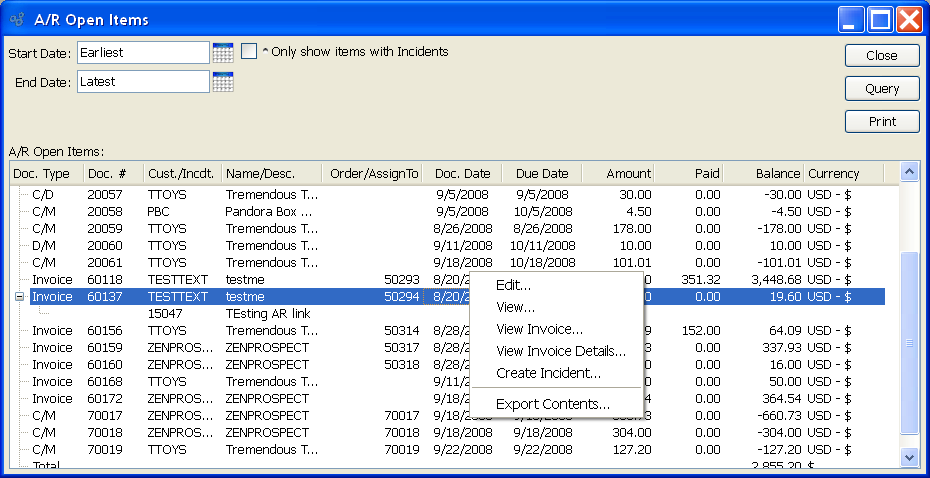
When displaying A/R open items, you are presented with the following options:
- Start Date
A/R open items having due dates on and after this date will be displayed.
- End Date
A/R open items having due dates on and before this date will be displayed.
- A/R Open Items
Display lists A/R open items, using the specified parameters.
To the far right of the screen, the following buttons are available:
- CLOSE
Closes the screen, returning you to the application desktop.
- QUERY
Select to generate the display, using the specified parameters.
Runs the report associated with this screen.
Right-clicking on an Item in the A/R open items list enables you to select from the following menu options:
If you right-click on an Invoice, the following additional option will be available:
To view A/R open items by Customer, select the "Open Items by Customer" option. The following screen will appear:
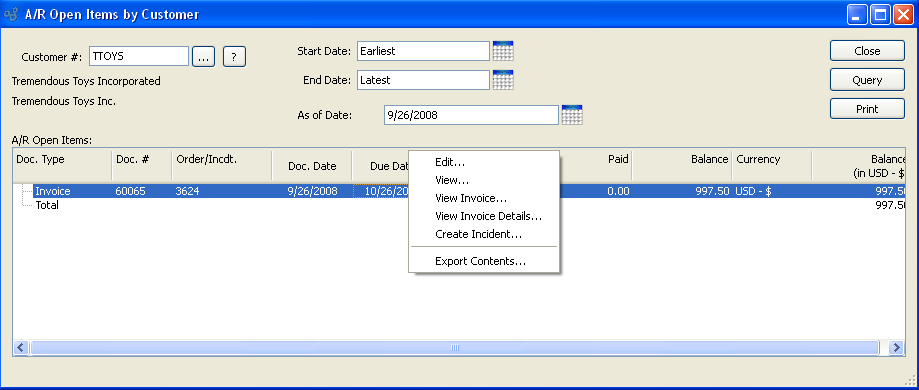
Note
If a Customer's open Accounts Receivable (A/R) balance exceeds their Credit Limit, the Customer will automatically be placed on Credit Warning. In addition, any new or open Sales Orders for the Customer will also be placed on Credit Hold.
When displaying A/R open items by Customer, you are presented with the following options:
- Customer #
Enter the Customer Number of the Customer whose A/R open items you want to display.
- Start Date
A/R open items having due dates on and after this date will be displayed.
- End Date
A/R open items having due dates on and before this date will be displayed.
- As of Date
-
Specify the date you want the A/R open items to be relative to. The report will include any A/R items which were open—that is, not yet paid—as of the specified date. This feature provides "point-in-time" open balance functionality.
Note
The payment date used as a reference for the "As of Date" field is the G/L distribution date, not the posting date.
- A/R Open Items
Display lists A/R open items by Customer, using the specified parameters.
To the far right of the screen, the following buttons are available:
- CLOSE
Closes the screen, returning you to the application desktop.
- QUERY
Select to generate the display, using the specified parameters.
Runs the report associated with this screen.
Right-clicking on an Item in the A/R open items list enables you to select from the following menu options:
If you right-click on an Invoice, the following additional option will be available:
To view Incidents that are associated with A/R open items, expand the selected item. The following information will appear:

Right-clicking on an Incident in the A/R open items list enables you to select from the following menu options:
The A/R Aging report gives you the ability to view A/R open items in a bucketed, time-phased perspective. And this perspective is portable, allowing you to view point-in-time snapshots of open balances.
An open Item is recognized by the A/R Aging report "as of" the item's document date. In the case of Invoices, the document date is the Invoice date—not the date the Invoice is distributed to the General Ledger (G/L) nor the date on which the Invoice is posted. (A/R Debit/Credit Memos are recognized on their document date.) For example, if you post an Invoice on January 1, but the Invoice date is February 15, then the "as of" date for that open item will be February 15. This means, if you run the A/R Aging report with an "as of" date in January, the open item with an Invoice date of February 15 will not appear in the report. In fact, it will not appear in the report until an "as of" date of February 15 or later is specified.
Tip
You can view the document date for an open item by right-clicking on a line in the A/R Aging display. You can also find open item details on other screens—for example, A/R Workbench, Customer History, Open Items by Customer, etc.
The grouping of open items into time-phased buckets is driven by a document's due date. In other words, if a due date falls within 0-30 days of the "as of" date specified when the report is run, then the open item will appear in the first bucket. If the due date falls 31-60 days past the specified "as of" date, then the open item will appear in the second bucket. And so on. But again, keep in mind that the document date for an A/R open item (e.g., Invoice date) must be on or before the specified "as of" date for the item to be recognized by the report.
To view open Accounts Receivable (A/R) open items from an aging perspective, select the "A/R Aging" option. The following screen will appear:
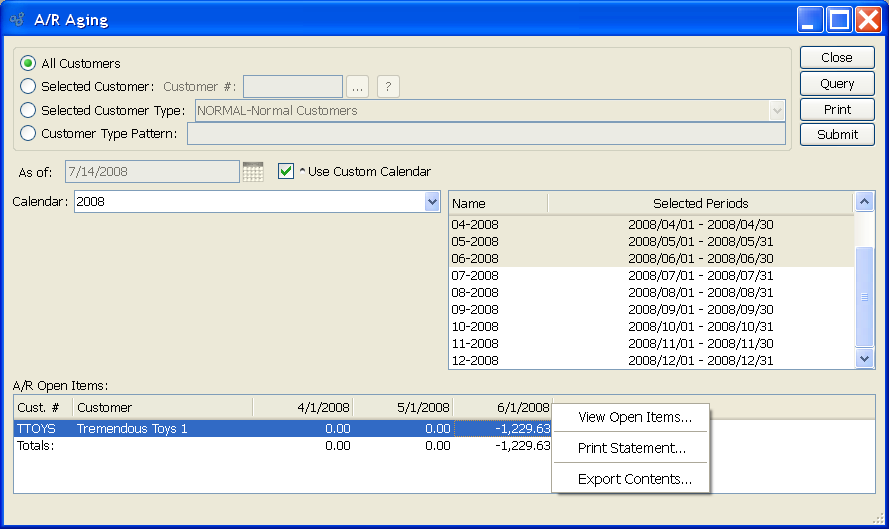
When displaying aging A/R open items, you are presented with the following options:
- All Customers
Select to display A/R open items for all Customers.
- Selected Customer
Select to display A/R open items for a selected Customer.
- Selected Customer Type
Specify Customer Type whose A/R open items you want to display.
- Customer Type Pattern
Enter a Customer Type pattern to select a range of Customer Types.
- As of Date
Specify the date you want the A/R open items to be relative to. The report will include any A/R items which were open—that is, not yet paid—as of the specified date. This feature provides "point-in-time" open balance functionality. But again, keep in mind that the document date for an A/R open item (e.g., Invoice date) must be on or before the specified "as of" date for the item to be recognized by the report.
- Use Custom Calendar
-
Select if you want to display A/R open items using a custom Calendar of your choosing.
If selected, the screen will present a series of different options, including the option to select a Calendar and associated periods.
- A/R Open Items
Display lists aging A/R open items, using the specified parameters.
To view A/R open items using a custom Calendar, select the "Use Custom Calendar" option above. The following screen will appear:

Note
If a Customer's open Accounts Receivable (A/R) balance exceeds their Credit Limit, the Customer will automatically be placed on Credit Warning. In addition, any new or open Sales Orders for the Customer will also be placed on Credit Hold.
When displaying A/R open items using a custom Calendar, you are presented with the following options:
- Calendar
-
Select the Calendar you want to use for the report.
Associated Calendar periods will be displayed.
- Name/Selected Periods
Select as many periods as you want to display. Selected periods correspond to Calendar specified in the "Calendar" field. Select individual periods or groups of periods together. To select an individual period, highlight the period using your mouse button. The period is now selected. To select a sequence of periods, highlight the first in the sequence using your mouse button. Then, holding down the SHIFT key on your keyboard, highlight the last period in the sequence. The entire sequence is now selected. To select periods that are out of sequence (e.g., January, April, July, October), highlight the first period in the group. Then, holding down the CTRL key on your keyboard, highlight the next period you want to select. Continue highlighting periods with the CTRL key depressed until all desired periods are selected. The entire group is now selected.
- A/R Open Items
Display lists time-phased A/R open items, using the specified parameters.
To the far right of the screen, the following buttons are available:
- CLOSE
Closes the screen, returning you to the application desktop.
- QUERY
Select to generate the display, using the specified parameters.
Runs the report associated with this screen.
- SUBMIT
Select to submit report to the Batch Manager.
Right-clicking on an Item in the A/R open items list enables you to select from the following menu options:
To view daily Invoice and Credit Memo transactions, select the "Invoice Register" option. The following screen will appear:
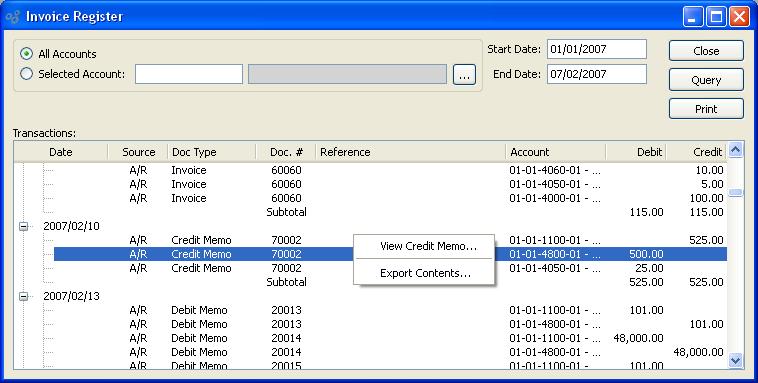
When displaying the Invoice Register, you are presented with the following options:
- All Accounts
Select to display Invoice and Credit Memo transactions for all G/L Accounts.
- Selected Account
Specify G/L Account whose Invoice and Credit Memo transactions you want to display.
- Start Date
Invoices and Credit Memos posted on and after this date will be displayed. This is a required field.
- End Date
Invoices and Credit Memos posted on and before this date will be displayed. This is a required field.
- Transactions
-
Display lists daily Invoice and Credit Memo transactions based on the specified parameters.
This display is a nested list, with a plus ("+") sign located to the far left of the display next to each date. By clicking your mouse on a plus sign, you reveal lower levels of information related to transactions on that date. In addition, the totals for the included transactions will appear at the bottom of the screen.
Tip
If a Ship-To Address was used for an Invoice, the Ship-To Address will appear in the Reference column of the Transactions display.
To the far right of the screen, the following buttons are available:
- CLOSE
Closes the screen, returning you to the application desktop.
- QUERY
Select to generate the display, using the specified parameters. Start date and end date must be entered for request to proceed. Results will be displayed in the "Transactions" list.
Runs the report associated with this screen.
Right-clicking on a Document in the Transactions list enables you to select from the following menu options:
To view the history of Cash Receipts and their applications by Customer, select the "Cash Receipts by Customer" option. The following screen will appear:
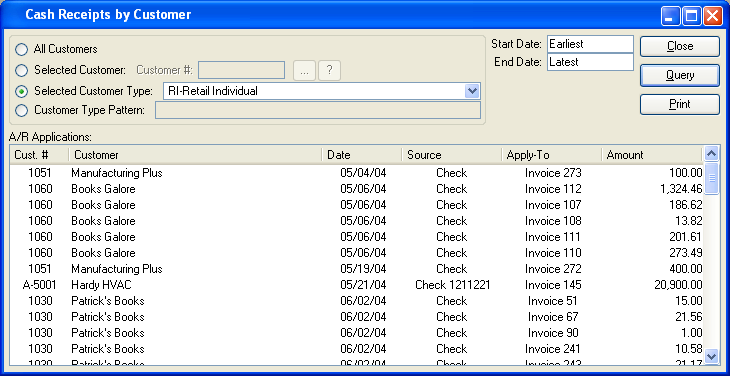
Note
The display will include unposted as well as posted Cash Receipts which have an apply-to document. Unapplied Cash Receipts will not appear on this screen.
When viewing Cash Receipts by Customer, you are presented with the following options:
- All Customers
Select to display Cash Receipt details for all Customers.
- Selected Customer
Select to display Cash Receipt details for a selected Customer.
- Selected Customer Type
Specify Customer Type whose Cash Receipt details you want to display.
- Customer Type Pattern
Enter a Customer Type pattern to select a range of Customer Types. Refine your search using Regular Expressions.
- Start Date
Cash Receipts entered on and after this date will be displayed.
- End Date
Cash Receipts entered on and before this date will be displayed.
- A/R Applications
Display lists Cash Receipt details, using the specified parameters.
To the far right of the screen, the following buttons are available:
- CLOSE
Closes the screen, returning you to the application desktop.
- QUERY
Select to generate the display, using the specified parameters.
Runs the report associated with this screen.
To view details concerning the application of Cash Receipts and Credit Memos to A/R open items, select the "A/R Applications" option. The following screen will appear:
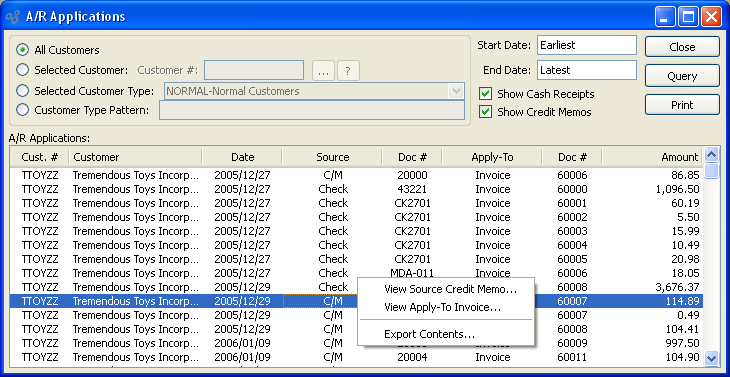
When viewing A/R application details, you are presented with the following options:
- All Customers
Select to display A/R application details for all Customers.
- Selected Customer
Select to display A/R application details for a selected Customer.
- Selected Customer Type
Specify Customer Type whose A/R application details you want to display.
- Customer Type Pattern
Enter a Customer Type pattern to select a range of Customer Types. Refine your search using Regular Expressions.
- Start Date
A/R applications made on and after this date will be displayed.
- End Date
A/R applications made on and before this date will be displayed.
- Show Cash Receipts
Select to display only Cash Receipt application details.
- Show Credit Memos
Select to display only Credit Memo application details.
- A/R Applications
Display lists A/R application details, using the specified parameters. The amount of each A/R Application is displayed in the document's Currency. The total amount of all applications during the period will display, normalized to the Base Currency using the Currency Exchange Rate effective on the document's Posting Date, at the bottom of the screen.
Tip
When you see the term "Other" in the "Apply-To" column, this typically refers to a Misc. Application made while entering a Cash Receipt.
To the far right of the screen, the following buttons are available:
- CLOSE
Closes the screen, returning you to the application desktop.
- QUERY
Select to generate the display, using the specified parameters.
Runs the report associated with this screen.
Right-clicking on a Document in the A/R Applications list enables you to select from the following menu options:
If you are right-clicking on a Credit Memo, the following additional option will be available:
To view the records of posted Cash Receipts, select the "Deposits Register" option. The following screen will appear:
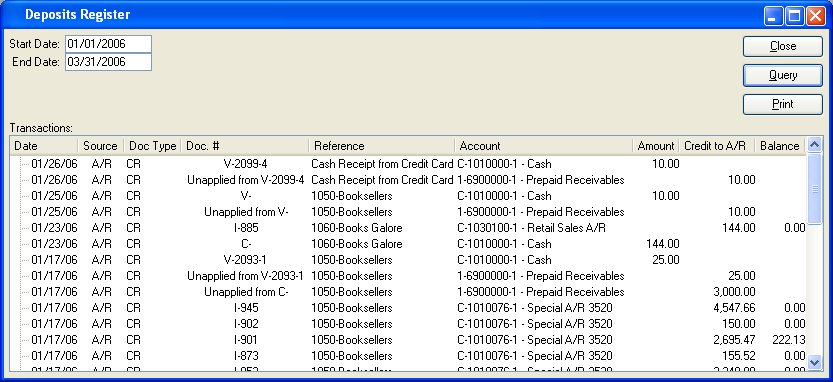
When displaying the Deposits Register, you are presented with the following options:
- Start Date
Cash Receipts posted on and after this date will be displayed.
- End Date
Cash Receipts posted on and before this date will be displayed.
- Transactions
Display lists posted Cash Receipts, using the specified parameters. The totals for the received and A/R application amounts will display at the bottom of the screen.
Note
The balance due amount displayed here refers to any open amount remaining on the A/R open item which the Cash Receipt was applied to. No balance due will appear for prepaid transactions.
To the far right of the screen, the following buttons are available:
- CLOSE
Closes the screen, returning you to the application desktop.
- QUERY
Select to generate the display, using the specified parameters.
Runs the report associated with this screen.
To view Customer history, select the "Customer History" option. The following screen will appear:
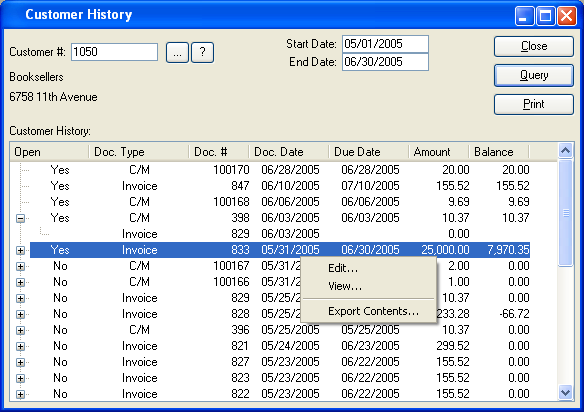
When displaying Customer history, you are presented with the following options:
- Customer #
Enter the Customer Number of the Customer whose history you want to display.
- Start Date
Documents whose document date falls on and following this date will be displayed.
- End Date
Documents whose document date falls on and before this date will be displayed.
- Customer History
Display lists Customer history, using the specified parameters. This display is a nested list, with a plus ("+") sign located to the far left of the display next to each Document that may be expanded to lower levels. By clicking your mouse on a plus sign, you reveal lower levels of information related to the Document.
To the far right of the screen, the following buttons are available:
- CLOSE
Closes the screen, returning you to the application desktop.
- QUERY
Select to generate the display, using the specified parameters.
Runs the report associated with this screen.
Right-clicking on a Document in the Customer History list enables you to select from the following menu options:
When posting Invoices in batch mode, you are given the option to print a Sales Journal. To print a Sales Journal, select the "Sales Journal" option. The following screen will appear:

When printing a Sales Journal, you are presented with the following options:
Note
There is no intended relationship between the Sales Journal Number and any Invoice Numbers appearing on the Sales Journal—even though the Journal Number prefix "AR IN" would seem to suggest a relationship.
- Journal Number
Specify the number of the Sales Journal you want to print. Sales Journals are created when Invoices are posted. The Journal Number you select will include both the Sales Journal Number and also the date when the Invoices were posted.
To the far right of the screen, the following buttons are available:
- CANCEL
Closes the screen without printing a Sales Journal, returning you to the application desktop.
Runs the report associated with this screen.
When posting Credit Memos in batch mode, you are given the option to print a Credit Memo Journal. To print a Credit Memo Journal, select the "Credit Memo Journal" option. The following screen will appear:

When printing a Credit Memo Journal, you are presented with the following options:
- Journal Number
Specify the number of the Credit Memo Journal you want to print. Credit Memo Journals are created when Credit Memos are posted. The Journal Number you select will include both the Credit Memo Journal Number and also the date when the Credit Memos were posted.
To the far right of the screen, the following buttons are available:
- CANCEL
Closes the screen without printing a Credit Memo Journal, returning you to the application desktop.
Runs the report associated with this screen.